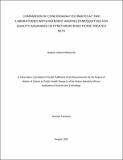Comparison of cone bioassay estimates at two laboratories with different anopheles mosquitoes for quality assurance of pyrethroid insecticide-treated nets
Abstract
This study explored utility of cone bioassays for pre-delivery quality assurance (QA) of pyrethroid
insecticide-treated nets (ITNs) to test the assumption that cone bioassays are consistent across
locations, mosquito strains, and laboratories. Double-blinded bioassays were conducted on 20
pyrethroid ITNs of four brands (100 nets, 5 subsamples per net) that had been delivered for mass
distribution in Papua New Guinea (PNG) having passed pre-delivery inspections. Cone bioassays
were performed on the same net pieces following World Health Organization (WHO) guidelines
at the PNG Institute of Medical Research (PNGIMR) using pyrethroid susceptible Anopheles
farauti sensu stricto and at Ifakara Health Institute (IHI), Tanzania using pyrethroid susceptible
Anopheles gambiae sensu stricto. Results from IHI and PNGIMR were compared using
Spearman’s Rank correlation, Bland-Altman (BA) analysis and analysis of agreement. In cone
bioassays, 13/20 nets (65%) at IHI and 8/20 (40%) at PNGIMR met WHO bio-efficacy criteria.
Results from IHI and PNGIMR correlated on 60-minute knockdown (KD60) (rs= 0.6, p= 0.002,
n=20) and 24-hour mortality (M24) (rs=0.9, p<0.0001, n=20) but BA showed systematic bias
between the results. The agreement between the results to predict ITN failure was good with
kappa=0.79 (0.53-1.00) and 90% accuracy. Based on these study findings, the WHO cone bioassay
is a reproducible bioassay for ITNs with >80% M24, and for all ITNs provided inherent stochastic
variation and systematic bias are accounted for. The 80% mortality (M24) threshold remains the
most reliable indicator of pyrethroid ITN quality using pyrethroid susceptible mosquitoes. In the
absence of alternative tests, cone bioassays could be used as part of pre-delivery QA.

